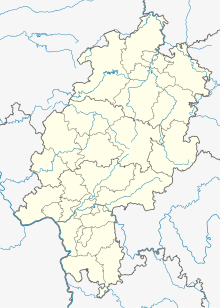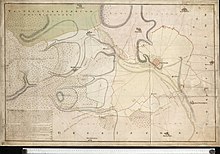Holzheim (Fritzlar)
Coordinates: 51 ° 6 ′ 43 ″ N , 9 ° 15 ′ 29 ″ E
Holzheim was a documented and inhabited village from at least 1040 to at least 1401 in the Ederniederung about 1.5 km south-southwest of Fritzlar and east below the Büraburg in the north Hessian Schwalm-Eder district .
history
The place entered German history briefly when on July 23, 1427 the Hessian Landgrave Ludwig I took over the troops of Archbishop Konrad III of Mainz . von Dhaun under Count Gottfried von Leiningen between Holzheim and the Kalbsburg near Großenenglis and thus finally decided in favor of the Landgraves in the two centuries-long struggle with Kurmainz for territorial supremacy in Northern Hesse. Mainz then had to take almost all of its possessions in Lower and Central Hesse from Hesse as a fief in the Peace of Frankfurt ; The only exceptions were Fritzlar, Naumburg , Amöneburg and Neustadt , over which the Landgrave, however, took over the patronage.
Although ceramic finds document the settlement of the place much earlier, it was first mentioned in a document in 1040, when Archbishop Bardo of Mainz bought the goods and unfree from the Benedictine monastery of Kaufungen in exchange. The village was subsequently given to the Lords of Holzheim as an Electoral Mainz fief. The Petersstift in Fritzlar, the German Order (since 1285), the monasteries of Haina , Hardehausen and Weißenstein and Eckebert von Grifte (reported 1313) also owned there. In 1348 the lords of Holzheim, who had been known since 1207, bequeathed the village and court to the lords of Falkenberg , but as early as 1369 there was a dispute within this family, which could only be ended when the city of Fritzlar took over the entire Falkenberger on behalf of the Archbishop of Mainz Bought property in the village.
The Falkenbergers bought the place and court back at least partially before 1400, but in 1411 the brothers Werner and Hans von Falkenberg gave the village and court of Holzheim a fief to Archbishop Johann II of Mainz and then received it back as a hereditary fief. At this point the place was probably already uninhabited. It was probably destroyed in the campaign of revenge of the Brunswick and Hesse, with which they responded to the murder of Duke Friedrich of Brunswick and Lüneburg , because the village belonged to the family of one of the murderers. Friedrich had been proposed in Frankfurt by several electors as the rival king to Wenceslaus of Luxembourg , but Archbishop Johann II of Mainz refused to support this proposal, and Friedrich left in disbelief. On his ride home he was on June 5, 1400 by Count Heinrich VII von Waldeck and his cronies Friedrich III. von Hertingshausen , Konrad (Kunzmann) von Falkenberg and a knight von Löwenstein , all feudal men of the Archbishop of Mainz , murdered near Kleinenglis , only a few kilometers from Holzheim.
It is certain that Holzheim was already a desert in July 1427, at the time of the decisive battle between Mainz and Hesse . The surviving residents moved to the new town of Fritzlar.
In place of the former village chapel, a branch of the mother church on the Büraberg, the city of Fritzlar built a watch tower , of which, however, no remains have survived today.
Archaeological excavations
In 1976, 1979–1985 and 1997, extensive archaeological excavations were carried out in the Holzheim desert. The aim of the interdisciplinary research project was to examine the social, economic and political-legal structure of the place and the living conditions of its residents over the entire settlement period of over 1200 years. Statements on this resulted from building finds (farmsteads with pit houses, post structures and later post structures, pits, wells, handicraft facilities, church, cemetery, manor house, castle), rich finds from many areas of material culture (ceramics, small finds, fibulae, ossuary, small Madonna sculptures , Kerbflöte) and abundant written documents and archive materials. The excavations provided important insights into a settlement from the Salier and Staufer times. It is important to provide evidence of fortified courtyard areas within a rather loose settlement and a castle-like structure developing from it.
literature
- Werner Ide: From Adorf to Zwesten. Local history pocket book for the Fritzlar-Homberg district. A. Bernecker Verlag, Melsungen, 1971, pp. 182-185.
- Norbert Wand: Holzheim near Fritzlar. Archeology of a medieval village (= Kassel contributions to prehistory and early history. Vol. 6). Publishing house Marie Leidorf, Rahden / Westf. 2004, ISBN 3-89646-266-0 .
- Johann-Henrich Schotten: The excavations of Büraberg and Wüstung Holzheim near Fritzlar. At the turn of the Merovingian to Carolingian times (= sources on the prehistory and early history of the Käfernburg-Schwarzburg lands. Vol. 1). A lecture on the occasion of the symposium on the early history of the Counts of Käfernburg-Schwarzburg in Engelsbach 1995. Thüringer Chronik-Verlag Müllerott, Arnstadt 1998, ISBN 3-910132-70-7 .
Web links
- "Holzheim (desert), Schwalm-Eder district". Historical local dictionary for Hessen. In: Landesgeschichtliches Informationssystem Hessen (LAGIS).

